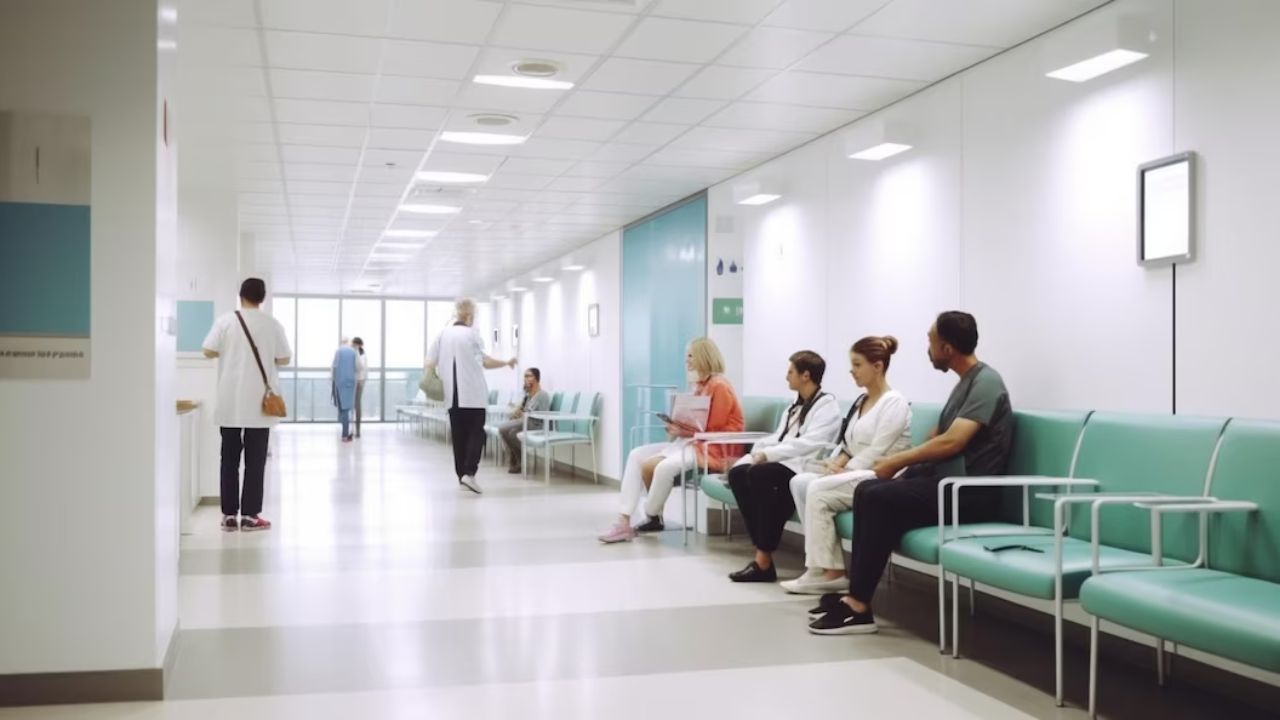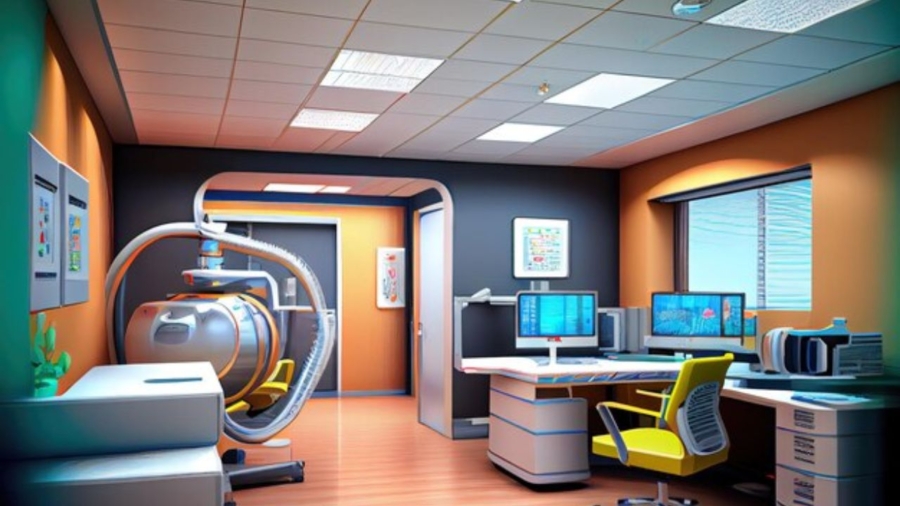In the ever-evolving landscape of healthcare, the Designing and Planning of hospitals stand as crucial pillars in shaping the quality of patient care, staff efficiency, and overall operational effectiveness. This blog seeks to provide an in-depth exploration of the multifaceted realm of Hospital Designing and Planning, shedding light on key considerations, innovative approaches, and emerging trends that are shaping the future of healthcare infrastructure.
I. The Significance of Hospital Designing and Planning:
The significance of Hospital Designing and Planning cannot be overstated in the realm of healthcare infrastructure. It represents the bedrock upon which the quality of patient care, staff efficiency, and overall operational effectiveness are built. A well-thought-out Hospital Designing and Planning process not only considers the functional aspects of space allocation and workflow optimization but also embraces patient-centric principles that profoundly impact the healing journey.
By strategically organizing clinical and non-clinical spaces through functional zoning, healthcare facilities can enhance accessibility, convenience, and compliance with regulatory standards. The infusion of technology into the fabric of hospital design ensures a seamless integration of innovative solutions, fostering collaboration among healthcare teams and bolstering the efficiency of medical processes.
In essence, the meticulous orchestration of Hospital Designing and Planning not only shapes the physical environment of healthcare institutions but also sets the stage for delivering optimal patient outcomes and fostering advancements in the field of medicine.

Patient-Centric Design:
In the realm of Hospital Designing and Planning, the paradigm of patient-centric design has become a guiding principle, placing the needs and experiences of patients at the forefront. Architects and designers collaborate closely with healthcare professionals to create environments that prioritize the comfort, well-being, and overall experience of patients.
Patient-centric design goes beyond the clinical aspect, incorporating elements such as natural light, soothing colors, and thoughtful layouts that enhance the healing atmosphere. Spaces are configured to promote privacy, accessibility, and ease of navigation, fostering a sense of control for patients and their families. Technology is seamlessly integrated to enhance communication and provide easy access to healthcare information.
By prioritizing patient-centric design in hospital planning, professionals contribute to an environment where compassionate care converges with functional efficiency, ensuring that healthcare facilities not only meet medical needs but also provide a supportive and positive experience for those seeking care.
1. The Impact of Design on Patient Experience
Hospital Designing and Planning play a pivotal role in shaping the overall patient experience within healthcare environments. The impact of design on patient experience is profound, influencing factors such as comfort, healing, and overall well-being. Thoughtful architectural choices, such as the layout of spaces, the incorporation of natural light, and the accessibility of facilities, contribute to a positive atmosphere that can alleviate stress and anxiety for patients.
Patient-centric designs prioritize the creation of healing environments, incorporating elements that enhance privacy, promote relaxation, and facilitate a sense of control. The utilization of advanced technology within the design further improves the efficiency of healthcare delivery, streamlining processes and enhancing communication.
A well-designed hospital can contribute significantly to a positive patient experience, fostering an environment where individuals feel supported, cared for, and confident in the quality of healthcare they receive. In essence, Hospital Designing and Planning directly impact the patient’s journey through the healthcare system, emphasizing the crucial role that thoughtful and patient-focused design plays in enhancing the overall healthcare experience.
2. Designing for Healing Environments
Designing for healing environments within the realm of Hospital Designing and Planning involves a deliberate and holistic approach aimed at fostering optimal conditions for patient recovery. Recognizing the profound impact of surroundings on well-being, architects and designers strive to create spaces that promote tranquility, comfort, and a sense of control for patients. Incorporating elements such as soothing colors, natural light, and access to green spaces, healing-focused designs aim to reduce stress and enhance the overall therapeutic experience.
Patient rooms are configured to maximize privacy and include amenities that support both physical and emotional healing. The integration of advanced technology is harmonized with a patient-centric ethos, facilitating seamless healthcare delivery while maintaining a human touch. The emphasis on designing for healing environments underscores a commitment to enhancing the overall patient experience and contributing to improved health outcomes, aligning Hospital Designing and Planning with a holistic vision of healthcare that extends beyond medical treatment alone.
3. Privacy and Dignity in Healthcare Spaces
Privacy and dignity in healthcare spaces are paramount considerations in the intricate process of Hospital Designing and Planning. Architects and designers strive to create environments that prioritize the preservation of patient confidentiality and personal dignity throughout the healthcare journey. Thoughtful layouts ensure discreet spaces for consultations, examinations, and treatments, allowing patients a sense of confidentiality in their interactions with healthcare professionals.
Patient rooms are designed to maximize privacy, with considerations for acoustics and visual separation. Moreover, the integration of private and well-designed spaces contributes to maintaining the dignity of patients during vulnerable moments, fostering a sense of control over their healthcare experience. The intersection of technology and design in healthcare spaces also plays a role, ensuring that electronic health records and communication systems are secure, further safeguarding patient privacy.
In essence, the commitment to privacy and dignity in Hospital Designing and Planning underscores a fundamental aspect of patient-centered care, recognizing that a respectful and private environment is integral to fostering trust and overall well-being in healthcare settings.
II. Key Components of Hospital Designing and Planning:
The key components of Hospital Designing and Planning encompass a multifaceted approach aimed at creating healthcare spaces that are both functional and patient-centric. Space planning strategies lie at the core, requiring meticulous allocation for different departments and a focus on flexibility to adapt to evolving needs.
Functional zoning plays a crucial role in organizing clinical and non-clinical areas, ensuring accessibility, and adherence to regulatory standards. Integrating infrastructure and technology into the Hospital Designing and Planning process is imperative, as it paves the way for smart hospital concepts, telemedicine facilities, and future-proofing designs to accommodate technological advancements.
Together, these key components form the foundation for Hospital Designing and Planning, facilitating efficient patient flow management, promoting collaboration among healthcare teams, and ultimately contributing to the creation of healthcare environments that prioritize both staff and patient well-being.

Space Planning Strategies:
Effective space planning is a cornerstone of Hospital Designing and Planning, encompassing a strategic approach to optimize the functionality and efficiency of healthcare facilities. Architects and designers employ meticulous strategies to allocate space judiciously, considering the specific needs of different departments, workflows, and patient experiences.
Efficient space planning involves creating flexible layouts that can adapt to evolving healthcare practices and technological advancements. Thoughtful consideration is given to patient flow, ensuring seamless navigation and minimizing wait times. Collaboration spaces, administrative areas, and clinical zones are organized to enhance interdisciplinary communication and cooperation.
The integration of adaptable designs not only accommodates the current needs of healthcare delivery but also anticipates future trends and challenges. Space planning strategies in hospital design aim to strike a delicate balance between functionality, patient-centric principles, and the dynamic nature of the healthcare landscape, contributing to the creation of environments that promote optimal care delivery and overall well-being.
1. Allocating Space for Different Departments
Efficient Hospital Designing and Planning hinge on the strategic allocation of space for different departments, a critical aspect in ensuring seamless healthcare delivery. Architects and planners meticulously designate areas for various departments, considering the unique requirements of each. Clinical departments such as emergency rooms, surgery suites, and diagnostic imaging demand proximity to streamline patient care pathways.
Administrative spaces are strategically positioned to enhance operational efficiency and staff collaboration. Patient rooms and wards are carefully arranged to balance the need for privacy with the accessibility of medical staff. Integrating cutting-edge technologies within these designated spaces is also vital for enhancing diagnostic and treatment capabilities.
The collaborative efforts of architects, healthcare professionals, and administrators are crucial in achieving a harmonious spatial layout that optimizes the functionality of different departments while prioritizing the overarching goal of providing high-quality, patient-centered care.
2. Flexibility in Space Design for Adaptability
Flexibility in space design is a pivotal aspect of contemporary Hospital Designing and Planning, responding to the dynamic and evolving nature of healthcare needs. Recognizing the ever-changing landscape of medical practices and technology, architects and designers prioritize creating adaptable spaces that can be easily modified to accommodate shifting requirements.
This flexibility is essential for seamlessly integrating new medical technologies, accommodating changes in patient demographics, and responding to unforeseen events such as health crises. The ability to reconfigure spaces ensures that healthcare facilities can efficiently evolve with advancements in medical science and emerging healthcare trends.
Whether it involves modular construction, easily reconfigurable interiors, or multipurpose spaces, the emphasis on adaptability in hospital design reflects a forward-thinking approach that anticipates and addresses the uncertainties inherent in the future of healthcare. Through flexible space design, hospital planning embraces a proactive strategy, ensuring that healthcare facilities remain resilient and responsive to the ever-changing landscape of medical practice and patient care.
3. Efficient Patient Flow Management
Efficient patient flow management is a critical consideration in the meticulous process of Hospital Designing and Planning. Architects and planners strategically organize spaces to optimize the movement of patients through various stages of care, ensuring a smooth and streamlined healthcare experience. The layout is carefully configured to minimize congestion, reduce wait times, and enhance the overall efficiency of medical services.
Considerations for proximity between different departments, strategically placed registration areas, and well-designed corridors all contribute to a seamless patient journey. Integration of advanced technologies, such as electronic health records and real-time tracking systems, further aids in managing patient flow effectively. The collaborative efforts of architects, healthcare professionals, and administrators are paramount in achieving an optimal spatial arrangement that not only prioritizes clinical efficiency but also enhances the overall patient experience by minimizing delays and facilitating timely access to medical care.
III. Designing Patient-Centric Spaces:
In the realm of Hospital Designing and Planning, the imperative of crafting patient-centric spaces stands as a pivotal aspect. The design of patient rooms plays a critical role in ensuring not only the comfort and privacy of individuals but also their overall well-being. Integrating infection control measures into room design is paramount, emphasizing the importance of creating environments conducive to healing and recovery.
Waiting areas, another integral component, demand careful consideration in Hospital Designing and Planning to be comfortable and welcoming, utilizing technology for effective information dissemination while efficiently managing patient flow. Emergency department design further underscores the need for patient-centricity, emphasizing rapid assessment and triage, coupled with seamless integration with other hospital areas. In essence, the meticulous Designing and Planning of patient-centric spaces underscore the commitment to enhancing the overall healthcare experience and positively impacting patient outcomes.

Patient Rooms:
Patient rooms are pivotal elements in Hospital Designing and Planning, representing spaces where healthcare meets personalized comfort and care. Architects and designers meticulously configure patient rooms to optimize functionality, privacy, and patient well-being. Thoughtful layouts consider ease of access for medical staff, integration of advanced healthcare technologies, and provision of ample natural light.
The design aims to create a healing environment by incorporating soothing colors, comfortable furnishings, and elements that promote a sense of control for patients. Attention is given to infection control measures, soundproofing, and the overall safety of occupants. Patient rooms are versatile spaces, designed to accommodate various medical needs while ensuring the dignity and privacy of patients.
The evolving landscape of healthcare delivery and patient expectations guides the continuous refinement of patient room designs, reflecting the commitment to enhancing the overall experience and outcomes for those receiving care within the hospital setting.
1. Comfort, Privacy, and Patient Well-being
In the realm of Hospital Designing and Planning, creating environments that prioritize comfort, privacy, and patient well-being is integral to fostering positive healthcare experiences. Architects and designers employ thoughtful strategies to ensure patient rooms and communal spaces are designed with the utmost consideration for comfort, providing a healing atmosphere.
The allocation of private and semi-private spaces, coupled with soundproofing measures, contributes to preserving patient privacy and dignity. Integration of natural light, soothing colors, and access to green spaces enhances the overall well-being of patients, recognizing the impact of the physical environment on mental and emotional health.
Patient-centric design principles are not only geared towards meeting clinical needs but also ensuring that the hospital setting promotes a sense of calm and security. In this way, Hospital Designing and Planning become instrumental in creating spaces that prioritize the holistic well-being of patients, contributing to positive health outcomes and a more compassionate healthcare experience.
2. Infection Control Measures in Room Design
In the meticulous process of Hospital Designing and Planning, infection control measures take center stage, reflecting a heightened awareness of the importance of mitigating the spread of infections within healthcare settings. Architects and designers play a crucial role in creating rooms that adhere to stringent infection control standards. Considerations for ventilation systems, materials that are easy to clean, and the strategic placement of hand hygiene stations are integrated into the design to reduce the risk of nosocomial infections.
Room layouts are planned to minimize cross-contamination, ensuring appropriate spatial configurations for medical equipment, and promoting efficient cleaning protocols. The emphasis on infection control in room design not only contributes to the safety of patients but also safeguards healthcare workers and visitors. Hospital planning, therefore, becomes a proactive endeavor, incorporating design elements that align with the highest standards of infection prevention, fostering a healthcare environment that prioritizes the well-being of all its occupants.
3. Integrating Family-Friendly Design Elements
Integrating family-friendly design elements is a fundamental aspect of creating a compassionate and supportive healthcare environment in Hospital Designing and Planning. Architects and designers strategically incorporate features that prioritize the needs of patients’ families, recognizing their essential role in the healing process. Design elements such as comfortable waiting areas, family lounges, and designated spaces for overnight stays aim to provide a welcoming and supportive atmosphere for families facing challenging times.
Considerations for clear wayfinding, convenient amenities, and spaces that facilitate open communication with healthcare professionals contribute to a more inclusive and family-centric healthcare experience. By integrating family-friendly design elements, hospital planning goes beyond the clinical aspect, fostering an environment that not only supports patients but also recognizes the importance of familial involvement in the healing journey.
IV. Sustainability in Hospital Design:
Sustainability in Hospital Designing and Planning represents a visionary approach to healthcare infrastructure that extends beyond immediate patient care considerations. Embracing green building practices, hospitals can implement energy-efficient design strategies, incorporating renewable energy sources and prioritizing the use of environmentally friendly materials.
Waste reduction and recycling initiatives are integral components of sustainability in healthcare design, aiming to minimize the ecological footprint of medical facilities. The pursuit of LEED certification not only aligns with sustainability goals but also brings about positive impacts on operational costs, a factor of considerable importance in Hospital Designing and Planning.
By incorporating these sustainable practices into the very fabric of healthcare infrastructure, hospitals can not only fulfill their environmental responsibilities but also contribute to community well-being and project an image of commitment to a healthier and more sustainable future.

Embracing Green Building Practices:
In the contemporary ethos of Hospital Designing and Planning, the integration of green building practices has become an imperative commitment towards sustainability and environmental responsibility. Architects and designers prioritize eco-friendly solutions, incorporating energy-efficient systems, renewable materials, and sustainable construction methods in healthcare facilities. Green building practices not only contribute to reducing the carbon footprint of hospitals but also promote a healthier indoor environment for patients and staff.
Attention to water conservation, waste reduction, and the use of environmentally friendly materials reflects a comprehensive approach to designing healthcare spaces. Embracing green building practices in hospital planning aligns with global efforts to mitigate climate change and fosters a culture of responsible resource management within the healthcare sector, demonstrating a commitment to creating facilities that are not only healing environments but also sustainable pillars of community health.
1. Energy-Efficient Design Strategies
In the realm of Hospital Designing and Planning, energy-efficient design strategies have emerged as crucial elements in constructing sustainable and environmentally conscious healthcare facilities. Architects and planners integrate innovative approaches to reduce energy consumption and minimize the ecological footprint of hospitals.
This includes the incorporation of energy-efficient lighting systems, utilization of renewable energy sources, and the implementation of advanced HVAC systems to optimize energy use. The integration of green building materials and the consideration of natural ventilation also contribute to creating more energy-efficient hospital spaces.
These strategies not only align with environmental responsibility but also offer long-term cost savings for healthcare institutions. By prioritizing energy-efficient design in hospital planning, professionals are not only contributing to a greener future but also ensuring that healthcare facilities operate efficiently, promoting both environmental sustainability and fiscal responsibility.
2. Waste Reduction and Recycling Initiatives
In the intricate process of Hospital Designing and Planning, waste reduction and recycling initiatives have emerged as integral components in fostering sustainable healthcare environments. Architects and designers incorporate innovative strategies to minimize waste generation and promote recycling within the complex healthcare infrastructure.
From the selection of recyclable materials to the implementation of efficient waste segregation systems, hospital designs aim to reduce the environmental impact of medical facilities. Considerations for sustainable waste management practices extend beyond the construction phase to the operational life of the facility.
Waste reduction initiatives not only align with environmental stewardship but also contribute to the overall sustainability goals of healthcare institutions. By prioritizing waste reduction and recycling in hospital planning, professionals play a pivotal role in creating facilities that not only cater to the health needs of communities but also reflect a commitment to responsible resource management and environmental conservation.
3. Selection of Environmentally Friendly Materials
In the realm of Hospital Designing and Planning, the selection of environmentally friendly materials stands as a crucial aspect of creating sustainable healthcare facilities. Architects and designers place a deliberate emphasis on choosing materials with low environmental impact, considering factors such as recycled content, renewable resources, and the overall life cycle of the materials.
From flooring to furniture, the integration of environmentally friendly materials contributes to reducing the ecological footprint of hospitals. Sustainable choices not only align with the global push towards environmental responsibility but also contribute to the well-being of patients and staff by ensuring indoor air quality and minimizing exposure to potentially harmful substances.
Hospital planning that prioritizes the selection of environmentally friendly materials reflects a commitment to both the health of the community it serves and the health of the planet, embodying a sustainable and responsible approach to healthcare infrastructure.
V. Regulatory Compliance and Guidelines:
In the meticulous process of Hospital Designing and Planning, regulatory compliance and adherence to guidelines are paramount considerations. Hospital infrastructure must align with local and international building codes, ensuring that structures meet stringent safety and quality standards. Complying with healthcare regulations is a critical facet, encompassing a range of factors from patient safety to facility security.
Hospitals must navigate a complex landscape of regulatory requirements in their Designing and Planning stages to guarantee the seamless delivery of healthcare services. Achieving Joint Commission accreditation, a gold standard in healthcare quality and safety, demands a comprehensive approach to Hospital Designing and Planning, emphasizing continuous quality improvement initiatives.
Ultimately, meticulous attention to regulatory compliance not only ensures the safety and security of healthcare environments but also fosters trust and confidence in the delivery of healthcare services to the community.

Adherence to Building Codes:
Adherence to building codes is a fundamental consideration in the meticulous process of Hospital Designing and Planning. Architects and designers navigate a complex web of local, national, and international building codes to ensure that healthcare facilities comply with stringent regulatory standards.
These codes encompass a wide range of safety, accessibility, and structural requirements, guiding the layout, construction, and operational aspects of hospitals. Compliance with building codes is imperative to guarantee the safety of patients, staff, and visitors, as well as to meet accreditation standards and legal obligations.
The design phase involves a rigorous evaluation of codes related to fire safety, structural integrity, zoning regulations, and accessibility standards, among others. By prioritizing adherence to building codes, hospital planners create environments that not only meet the highest standards of safety but also instill confidence in the community, reinforcing the role of healthcare facilities as pillars of well-constructed and secure community infrastructure.
1. Navigating Local and International Standards
Navigating local and international standards is a paramount consideration in the intricate process of Hospital Designing and Planning. Architects and designers must adeptly navigate a complex web of regulations, codes, and guidelines that vary across regions and countries. Local standards ensure that healthcare facilities comply with specific regulations, building codes, and zoning requirements unique to the community they serve.
Simultaneously, adherence to international standards guarantees that hospital designs align with globally recognized best practices, fostering interoperability and facilitating the exchange of knowledge in the field. Successfully navigating this multifaceted landscape requires a thorough understanding of both local and international standards, ensuring that hospital planning not only meets regulatory requirements but also achieves the highest levels of safety, efficiency, and quality of care on a global scale.
2. Compliance with Stringent Healthcare Regulations
Hospital Designing and Planning necessitate meticulous attention to compliance with stringent healthcare regulations to ensure the delivery of safe and high-quality medical services. Architects and designers work collaboratively with healthcare professionals to integrate these regulations seamlessly into the architectural framework of the facility.
From fire safety measures and building codes to infection control standards and accessibility requirements, every aspect of hospital design must adhere to these stringent regulations. Compliance not only guarantees the safety of patients, staff, and visitors but also plays a crucial role in meeting accreditation standards and legal obligations.
Navigating this complex regulatory landscape demands a nuanced understanding of local, national, and international healthcare standards, emphasizing the need for a comprehensive and detail-oriented approach in hospital planning. By prioritizing compliance, healthcare facilities not only meet legal and safety standards but also create an environment conducive to optimal patient care and well-being.
3. Ensuring Safety and Security in Hospital Design
Ensuring safety and security is a paramount consideration in the intricate process of Hospital Designing and Planning. Architects and designers work diligently to create healthcare facilities that prioritize the well-being of patients, staff, and visitors. Strategic layouts and access control measures are implemented to enhance overall security, preventing unauthorized access to sensitive areas.
Emergency egress routes, fire safety protocols, and robust infrastructure are incorporated to guarantee the safety of occupants during critical situations. Additionally, the integration of advanced surveillance systems and technology ensures continuous monitoring, adding an extra layer of security. By addressing safety and security concerns comprehensively, hospital planning not only meets regulatory requirements but also instills confidence in the community, fostering an environment where patients can focus on their well-being without concerns about their safety.
VI. Emerging Trends in Hospital Designing and Planning:
In the dynamic landscape of healthcare, emerging trends in Hospital Designing and Planning are shaping the future of medical facilities. The integration of artificial intelligence (AI) is revolutionizing the planning phase, with applications in diagnostic and treatment planning, enhancing precision and efficiency. Robotics in surgical suites is becoming a prominent trend, offering surgical teams advanced tools for intricate procedures.
Virtual assistants are being employed to enhance the overall patient experience, providing information and support. Modular design concepts are gaining traction, offering flexibility for future expansion and quick deployment of new facilities, aligning with the ever-changing healthcare demands. Moreover, the human-centered design approach is prioritizing the well-being of healthcare staff, engaging them in the design process, and recognizing the profound impact of workplace environments on recruitment and retention.
As hospitals embrace these emerging trends, they position themselves at the forefront of innovation, ensuring that their Designing and Planning strategies align with the evolving needs of both patients and healthcare professionals.

Integration of Artificial Intelligence:
The integration of Artificial Intelligence (AI) in Hospital Designing and Planning marks a transformative era in healthcare architecture. Architects and designers are tasked with creating spaces that seamlessly accommodate the infrastructure required for the implementation of AI technologies. AI applications in diagnostics, treatment planning, and administrative tasks are revolutionizing the healthcare landscape, enhancing precision and efficiency.
The design considerations encompass not only the physical space but also the integration of data networks and computational systems to support AI algorithms. As hospitals increasingly embrace AI as a valuable tool in patient care, the planning and design phase becomes pivotal in ensuring that the built environment aligns with the evolving needs of technologically advanced healthcare delivery.
The integration of AI in hospital design underscores a commitment to harnessing cutting-edge technologies for improved patient outcomes, setting the stage for a future where architecture and artificial intelligence seamlessly converge in the service of optimal healthcare provision.
1. AI Applications in Diagnostic and Treatment Planning
In the evolving landscape of Hospital Designing and Planning, the integration of Artificial Intelligence (AI) applications has become instrumental, particularly in the realms of diagnostic and treatment planning. Architects and designers are incorporating advanced technologies to accommodate the infrastructure needed to support AI applications seamlessly.
AI-driven diagnostic tools, such as image recognition and pattern analysis, are transforming the accuracy and speed of medical diagnoses. Treatment planning benefits from AI algorithms that analyze vast datasets to recommend personalized and evidence-based interventions. The incorporation of these technologies requires flexible and adaptable spaces within hospital designs to accommodate the evolving requirements of AI systems.
As AI continues to play a pivotal role in enhancing medical practices, its integration into hospital planning is essential for creating facilities that not only meet current diagnostic and treatment needs but also possess the agility to embrace future advancements in artificial intelligence and healthcare technology.
2. Robotics in Surgical Suites for Precision and Efficiency
Hospital Designing and Planning are witnessing a transformative integration of robotics, particularly in surgical suites, to enhance precision and efficiency in medical procedures. Architects and designers are incorporating state-of-the-art technology to accommodate the specific infrastructure required for the seamless incorporation of robotic systems.
Robotic-assisted surgeries have emerged as a game-changer, allowing surgeons to perform complex procedures with enhanced precision and minimal invasiveness. The design of surgical suites now includes considerations for specialized robotic equipment, optimal spacing, and adaptable layouts to facilitate the integration of these advanced technologies.
Robotics not only revolutionize surgical capabilities but also demand a forward-thinking approach to spatial planning, ensuring that hospital designs are flexible enough to accommodate the evolving landscape of robotic-assisted medical interventions. As hospitals continue to embrace the potential of robotics in surgical settings, the synergy between technological innovation and thoughtful design becomes increasingly vital for delivering superior healthcare outcomes.
3. Enhancing Patient Experience with Virtual Assistants
The landscape of Hospital Designing and Planning is undergoing a paradigm shift with the integration of virtual assistants aimed at enhancing the overall patient experience. Architects and designers are incorporating spaces within healthcare facilities that are conducive to the integration of virtual assistant technologies.
From reception areas to patient rooms, these intelligent systems contribute to a more patient-centric environment. Virtual assistants can provide information, facilitate communication, and offer personalized support, creating a seamless and interactive experience for patients. The design considerations include accommodating the necessary technology infrastructure and ensuring that the physical layout promotes ease of use and accessibility.
By embracing virtual assistants in hospital planning, healthcare facilities not only streamline processes but also foster a technologically advanced and patient-friendly atmosphere, contributing to an overall positive healthcare experience for patients and their families.
Conclusion:
Hospital Designing and Planning are integral components of healthcare infrastructure development, shaping the future of medical facilities. By prioritizing patient-centered design, operational efficiency, and sustainability, healthcare institutions can ensure they are equipped to meet the evolving needs of patients and the community. Staying abreast of emerging trends and adhering to regulatory guidelines positions hospitals to not only provide high-quality care but also contribute to the advancement of healthcare as a whole. In the dynamic landscape of healthcare, strategic planning and thoughtful design are essential for creating spaces that foster healing, collaboration, and innovation.
FAQs about Hospital Designing and Planning
1. What factors should be considered in hospital designing and planning?
Hospital designing involves a comprehensive approach, considering factors such as patient flow, safety standards, accessibility, and functionality. Planners must take into account the specific needs of different departments, medical equipment requirements, and the potential for future expansion.
2. How does technology influence hospital design and planning?
The integration of advanced medical technologies plays a crucial role in hospital design and planning. FAQs in this category may cover topics like the incorporation of digital health systems, smart building features, and the provision for telemedicine services. Understanding how technology impacts healthcare delivery is essential for creating a modern and efficient hospital environment.
3. What are the key considerations for creating a patient-centered hospital design?
Patient experience is a critical aspect of hospital design. FAQs on this topic might address issues such as the design of patient rooms, waiting areas, and the overall layout to ensure a comfortable and healing environment. Additionally, questions may focus on strategies for minimizing stress and improving navigation for patients and their families.
4. How does sustainability play a role in hospital design?
Sustainability is increasingly becoming a focus in healthcare facility planning. FAQs could cover topics related to energy-efficient design, waste management, and the use of eco-friendly materials. Understanding the principles of sustainable hospital design is essential for creating facilities that are both environmentally responsible and cost-effective.
5. What challenges should be anticipated in hospital design and planning?
This FAQ could explore the common challenges faced in hospital design, including budget constraints, regulatory requirements, and the need to balance functionality with aesthetics. Addressing these challenges requires a thorough understanding of the healthcare industry, collaboration with various stakeholders, and a proactive approach to problem-solving.


